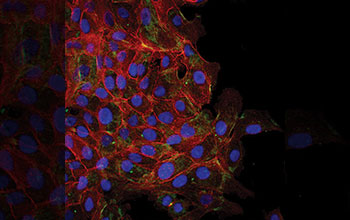Multimedia Gallery
Normal epithelial cells primed on a stiff matrix
These normal epithelial cells primed on a stiff matrix store a mechanical memory of their past matrix stiffness and continue to show high expressions of force-generating proteins even after arriving on a soft matrix (actin in red, myosin in green and cell nuclei in blue).
More about this image
In the body, cells move around to form organs during development, to heal wounds, and when they metastasize from cancerous tumors. A mechanical engineer at Washington University in St. Louis found that cells remember the properties they had in their first environment for several days after they move to another in a process called mechanical memory.
Amit Pathak, an assistant professor of mechanical engineering and materials science in the School of Engineering and Applied Science at Washington University in St. Louis, spent three years using mechanobiology and materials science to find answers to these questions: If cells sit in one environment and move to another one, do they remember the first one, and do they inherit any of the properties of the first environment?
To prove his hypothesis, Pathak created a device from which he can measure how long the cells' memory lasts in the new environment. The device, which has a U.S. patent pending, has two sides divided by a barrier. Samila Nasrollahi, a graduate student in Pathak's lab, placed cells in the stiff side of the device -- a similar environment to a malignant tumor. After a few days, she removed the barrier and the cells quickly invaded the other side of the device, which is a soft environment. In addition, they found that the cells maintain the properties they had in the stiff environment for three days in the new environment, due to retaining the YAP gene in the nuclei. The YAP gene is amplified in human cancers.
"Removing the barrier could be similar to the process of cancer cells escaping the primary tumor by breaking through the surrounding tissue, which is the genesis of metastasis," Pathak said.
Pathak says the device mimics a tumor environment in the body. "This answers one of the crucial questions in tumor invasion," Pathak said. "If the tumor cell leaves a very stiff active environment and goes to soft surrounding tissue, why don't they stop there, because a soft microenvironment is known to slow migration?"
This research was supported by the U.S. National Science Foundation (grant CMMI 1454016).
Read more in the NSF News From the Field story Cells' mechanical memory could hold clues to cancer metastasis. (Date image taken: 2016; date originally posted to NSF Multimedia Gallery: May 29, 2018)
Credit: Samila Nasrollahi and Amit Pathak, Washington University
Images and other media in the National Science Foundation Multimedia Gallery are available for use in print and electronic material by NSF employees, members of the media, university staff, teachers and the general public. All media in the gallery are intended for personal, educational and nonprofit/non-commercial use only.
Images credited to the National Science Foundation, a federal agency, are in the public domain. The images were created by employees of the United States Government as part of their official duties or prepared by contractors as "works for hire" for NSF. You may freely use NSF-credited images and, at your discretion, credit NSF with a "Courtesy: National Science Foundation" notation.
Additional information about general usage can be found in Conditions.
Also Available:
Download the high-resolution JPG version of the image. (31.7 MB)
Use your mouse to right-click (Mac users may need to Ctrl-click) the link above and choose the option that will save the file or target to your computer.



